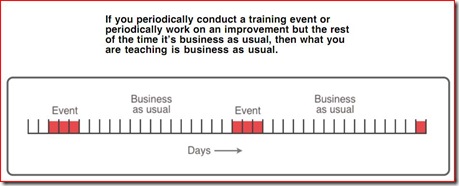Mike Rother shared an overview presentation on the “Improvement Kata.”
The words on one graphic really jumped out at me:
Aside from his intended point that you never get good at anything but “business as usual” if “business as usual” is what you do most of the time, there are some other implied questions.
First of all, if there were only 15 days between improvement events, that would be overwhelmingly better than what I normally see. Typically a particular area can see months go by between scheduled improvement events.
Most organizations (how about yours?) seem to believe that once an improvement event (or a “belt project”) is concluded, that people should just “follow the new process” to hold the gains.
No wonder we see the advice to “fix it again!” We have to fix it again just to restore it to where it was after it erodes.
But there is a deeper question here.
What kind of “improvement processing” is this? Are we moving toward “one by one flow of improvements” or are we running improvements in batches?
This is batch improvement. We are doing a changeover, running the improvement process, then doing another changeover, and running business as usual.
Unless business as usual includes a robust and reliable process for detecting small problems, responding immediately, clearing them, and solving them, nobody but the event facilitators are learning how to do improvements. People may be learning about improving, but unless they are doing it every day, they are not getting particularly good at it.
Want to see evidence of this? What happens between the events? Do things get better or worse? If “business as usual” includes improvement, things will get progressively better, and you can stop reading this because your organization gets it.
So here are a few questions for you.
Assuming you want to strive for true, daily, continuous improvement, what is the next step you plan to take in that direction?
How will your “business as usual” operate when you take that step?
How is it operating now? What is the gap?
What is stopping you from doing that now? If nothing, then do it now, and cycle back to the first question.
Which of those problems are you working on next?
When are you going to be able to check your results and learn what the next incremental target is?
Now – head down to your work area and ask yourself how you expect problems to be handled. Then watch and see what is actually happening when problems are encountered.
In other words, let’s manage improvements the same way we are asking everyone else to manage production.

Hi Mark, your link is missing its final “a”. It’s http://www.slideshare.net/mike734/introduction-to-the-improvement-kata
Regards,
Mike (@asplake)
Thanks – I just fixed it.